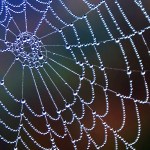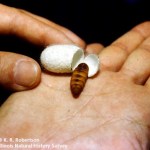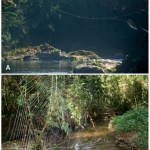silk
Image via NOAA/Flickr
Pacific hagfish (Eptatretus stoutii), aka "slime eels", are primitive fish that occupy burrows on the ocean floor. Like earthworms, they have 5 hearts. They have no true eyes, no jaws, nor do they have a stomach. They locate their meals through great senses of smell and touch. In addition to small invertebrates, they are known for consuming carrion that fall to the ocean floor. By consume, I mean burrow into the decomposing carcasses and eating them from the inside out. Ew. Given their dietary habits, it is no surprise they are regularly exposed to little to no…
Modern science stands on the shoulders of giants, as well as average humans, dwarves and elves, ancient civilizations, and all the bones of the dead—forgotten and otherwise. But sometimes you have to start a new branch of science from scratch. On Uncertain Principles, Chad Orzel continues his count-up to Dec. 25, the birthday of Sir Isaac Newton. Orzel explores the origins of agriculture in the Americas, where nativized people made the best of their local flora, turning a humble, nearly inedible grass into one of the biggest food staples on Earth. Chad writes, "Our other staple crops are also…
Image of wet spider web from www.photoforum.com
The US Navy has decided to sponsor research conducted by Dr. Randy Lewis, a specialist in spider silk, at Utah State University. Their interest in the research lies in the ability for spider silk to maintain adhesiveness even under wet conditions. Therefore, Navy officials are seeking to create a synthetic spider silk that they can manufacture for use as an underwater adhesive.
Source:
Utah State University
Dr. Marcus Atlas, from the Ear Science Institute in Australia, and his team have pioneered a novel treatment for repairing damaged eardrums using silk obtained from silkworm cocoons, like the one pictured above.
There was some big news yesterday in transgenic silk from Notre Dame and the University of Wyoming, where scientists have genetically engineered silkworms to produce silk that is a mixture of spider silk and the regular silkworm stuff. Silkworms produce the strong and versatile silk that is used to make clothes, but spiders produce silk that can be much stronger and much more elastic. Spiders, however, don't like to be grown in huge factories and don't make easily harvested cocoons like silkworms, so gathering even small amounts is very difficult (here's a fun how-to for collecting spider…
Silk is an amazing biomaterial, cultivated and prized for more than 5,000 years. The silk threads that we weave into our shiny fabrics are actually enormous protein crystals produced by insects. This industrial silk that you can buy at the mall is made by silkworms, which use the silk to form the cocoon that protects them as they transform into moths. Many other species of insect also produce silk proteins to protect themselves or their eggs, get around, or catch their prey, but none in such enormous quantity in such easy to harvest packages as the silkworm. Silks from different species are…
My silkworms are starting to turn into silkmoths! The first moth emerged from his cocoon this weekend, I hope more are close behind so that he can mate before he dies! I didn't expect him to come out so soon so I didn't have my real camera but I wanted to share my blurry phone pictures of the event:
In industrial silk production they can't use the cocoon that gets left behind because the moth uses an enzyme called cocoonase to chew his way out, breaking the otherwise continuous silk thread. I'm starting to explore ways that I can use this silk though--so far I've only made friendship…
Commenter JohnV asked me whether I had let any of my silkworms crawl on an LB plate (what microbiologists use to grow colonies of bacteria) to see what kind of bacteria is living on them in case I ever suffer from catastrophic experiment contamination. I hadn't thought of what kind of bacteria could be living on my silkworms (we are thinking about what kind of bacteria live in their digestive systems that help them digest leaves) so I tried it out! I let one of my wormies crawl on a plate, and I touched one with my relatively clean fingers as a pseudo-control.
I let the plates incubate at 37…
So I had this great post planned about the Boston aquapocalypse but by the time I managed to get some water samples to the lab they had started heavily chlorinating the water and no bacteria were left! Since negative results don't make for good blog posts, please enjoy this video of my silkworms dancing to Flo Rida's Right Round instead.
Silks are incredible protein fibers produced by many different species of insects. Besides their use in making versatile textiles, silks are currently used in many different medical and engineering applications, from sutures to tissue engineering scaffolds to flexible electrode brain implants. Since I love fabrics and I'm interested in what biological engineers can do with biomaterials, I recently started working on a fun side project to raise and engineer silkworms, the animals used in industrial silk production around the world. We're having a lot of fun learning about silk and how to raise…
Tougher than steel and Kevlar, the silk of the black widow spider has long been coveted by manufacturing companies, defense contractors and comic-book reading nerds as a possible material of the future.
Scientists have spent years decoding pieces of the spiders' silk making genes, but now Nadia Ayoub and a group of researchers at the University of California-Riverside can create the full proteins and probably spider silk as well.
You want to manufacture my what!?
The silk making genes turn out to be quite long (over 10,000 base-pairs), but with very few introns or "junk DNA" sections that…



